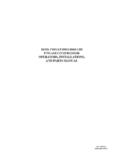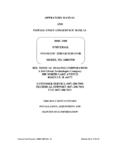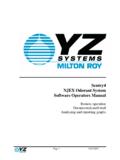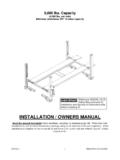Transcription of General Operators Instructions Maintenance Manual
1 Weight1 Inch x Inch25 mm x 29 mm4650 OverallLengthHousing Inches(42 mm)Working AirConsumption20 CFM( L/S)TC-1-E Series Needle Scalers Model Throttle Bore and Blows per Number Type Stroke Minute TC-1-ENL Lever Lb.( Kg) Inch (390mm) TC-1-ENP Push Lb.( Kg) Inch (408mm) TC-1-ENBW Offset Lb.( Kg) Inch (407mm) General Operators InstructionsandMaintenance ManualTC-1-E SeriesScalers/Needle ScalersTop Cat Air Tools, Manufactured by Service Pelton Road, Willoughby, OH 44094 : (440) 954-7500 or (800) 321-6876 Fax: (440) 954-7118 or (877) 800-3589 E-Mail: Web Site: Safety Recommendations Before Operating Tool Model Throttle Bore and Blows per Number Type Stroke Minute TC-1-EL Lever Lb.
2 ( Kg) Inch (239mm) TC-1-P Push Lb.( Kg) Inch (256mm) TC-1-EBW Offset Lb.( Kg) Inch (255mm) 1400 Push Lb.( Kg) Inch (253mm) 1401 Flow Through Lb.( Kg) Inch (239mm)Weight1 Inch x Inch25 mm x 29 mm4650 OverallLength Housing Inches(42 mm)Working AirConsumption20 CFM( L/S)TC-1-ENL14001401TC-1-ELTC-1-E Series ScalersThis is meant to highlight sections of safety standards published by the American National Standards Institute and the Occupational Safety and Health Administration. This is not meant to replace those standards but only highlight certain areas.
3 When care is taken to ensure that the right tool is operated properly, and safety and Maintenance procedures are followed, accidents can be avoided. Read and follow all Instructions and directions. Comply with all rules governing the use of power tools, personal protective equipment and equipment - machines, attachments and accessories must be used only for the purpose for which they were designed. Safety reasons and product liability prohibit any modifications to tools. Any attachments or accessories must be agreed to in advance with an authorized technical representative of Service Co. Operators Instructions and Safety PrecautionsAlways wear eye and hearing protection, and when necessary, other personal protective equipment such as gloves, an apron, and helmet. Check hose size and air pressure. The air pressure at the tool shall not exceed 90 psi ( bar). All hoses should be inspected regularly and kept away from heat, oil and sharp edges.
4 Be sure the tool is secured to the air mounting of inserted tooling is crucial to safe operation and efficient working conditions. Ensure the exhaust air is directed away from bystanders. Disconnect the tool from the air supply before doing any service. This prevents accidental start-ups. Airborne particulate resulting from the metal removal process can cause hazards. Wear appropriate protective equipment. The safety procedures for operating air tools are everyone s responsibility. The following lists several aspects of air tool safety that should be considered during operation. Please be aware of the these aspects and report any unsafe practice you see to a supervisor or safety officer immediately. 1) The inserted tool on heavy types of percussive, non-rotary power tools is exposed to heavy strains and can after long period of use break due to ) Unexpected tool movement or breakage of inserted tool may cause injuries to the lower limbs, in particular the feet.
5 3) Unsuitable postures may not allow counteracting of normal or unexpected movement of the power tool. (A working position shall be adopted which remains stable in the event of a break up of the inserted tool.)4) Support the work piece ) Holding the inserted tool by the free hand can be a source of vibration ) If the tool jams, shut off the power and ease the chisel free. (Check the chisel for damage before continuing operation.)7) Ensure that sparks from the process do not create a hazard to eyes or will ignite the environment. 8) Percussive tools shall not be used in potentially explosive atmospheres. 9) Pneumatically driven tools are nor generally insulated from coming into contact with electric sources. Be sure to avoid contact with wires or other possible current carrying sources. 10) The operator must check that no bystanders are in the vicinity. 11) Disconnect the power supply before servicing and changing of inserted tooling.
6 12) Release control device in case of interruption of energy supply. 13) Always keep the tool in a clean, dry place when not in use. 14) Do not hold tool near body when operating. 15) Keep firm grip on tool during operation. 16) Do not chisel toward your body. 17) If a quick disconnect hose fitting is used, insert a whip hose between coupling and the ) Never carry a tool by the ) Never yank the hose to disconnect it from the air ) Keep hoses away from heat, oil, sharp edges and in good repair - inspect ) Check to see that tool is securely fastened to air ) In air hoses larger than inch, a safety excess flow valve must be installed at the source of the air supply to reduce pressure in case of hose ) Before operating the tool, see that a safety clip or retainer is installed and working to prevent attachments such as chisels, needles or other implement from being ejected from the tool when operated.
7 Because these retaining devises receive substantial abuse and wear, they should be inspected regularly and replaced when damage or wear is noted. 24) Never leave a tool attached to supplied air unattended. Avoid accidental ) Always disconnect the tool from the air supply or shut off and drain the air hose prior to changing chisels, needles or other ) Never point or direct a tool toward another worker or ) When working in close proximity to other workers, suitable barriers may need to be erected around work areas to protect workers from possible tool ejections or flying pieces from the removal process itself. 28) Be sure to wear the properly fitted personal protective equipment required to guard against operator in OperationMaintenanceBW - Offset HandleP - Push HandleAssembly1. Be sure all parts are clean and free of any Scaler2. Support the lower valve block (832508) under an arbor press.
8 3. Press the pins (832126) into the blind holes of the lower valve block until they bottom. (The blind holes are those that are parallel to the axis of the part. The pins should bottom with a shoulder in the bottom of the holes.) 4. Place the valve (832196) into the recessed center of lower valve block. 5. Place upper valve block (832173) onto valve assembly. Aligns the pins in the blind holes of the upper valve block. (The blind holes are those that are parallel to the axis of the part.)6. Support the valve assembly on a small, round support that is smaller in diameter that the inside of the barrel. The lower valve block should be oriented toward the upward direction. Place the piston (832373) onto the lower valve block. The protrusion on one end of the piston should be oriented toward the upward Slip the rear of the barrel over the valve assembly and piston until the valve assembly bottoms.
9 Grasp the support fixture and barrel. Turn the barrel assembly over. (This technique of assembly will ensure the valve assembly does not separate during installation.)8. Clamp the barrel assembly in the vise vertically with the front of tool oriented toward the downward direction. Clamp onto the flats on the front of the barrel. 9. Screw the lock ring (832882) onto the backhead assembly. The taper of the lock ring should be oriented toward the front of the backhead assembly. 10. Screw on the backhead assembly into the back of the barrel assembly. Tighten the backhead with use of a wrench. (Spacers (832947A) can be put into the barrel in order to orient the handle of the backhead in a given direction.)11. Screw down and tighten the lock ring against the barrel. Remove from vise. 12. Clamp the tool in a vise vertically with the front of tool toward the upward direction. Clamp onto the flats of the Place the wedge (832956) and buffer (833527) into the cut-out section of the front barrel.
10 14. Expand the retaining clip (832554) and secure over wedge and buffer. The Needle Shell Attachment15. Slide 19 needles (834046) into the needle holder (834046). The larger end of the needle should fall into the recessed holes of the needle holder. 16. Slip the spring (834044) over the front of the needles and up to the needle holder. 17. Drop the needle assembly into the rear of the needle shell (834779). 18. Pull the tab of the wedge up on the tool and slide in the the needle driver (834045). needle shell with one hand and backhead with the other. 20. Push and twist the needle shell assembly until the lever of wedge is set in a notch of the needle Disconnect tool from air supply and remove all Needle Shell Attachment2. Grasp needle shell (834779) with one hand and backhead (869310B) with the other. 3. Push and twist the needle shell until the lever of wedge (832956) is free from the Slide the internal parts from the needle shell.








